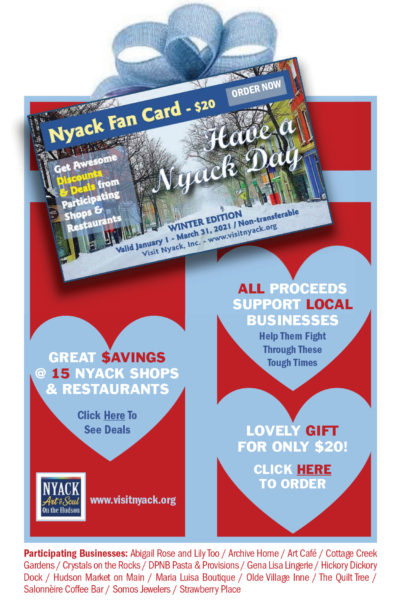A cloud of steam gushed from the locomotive as it approached the station of milling passengers. The locomotive came closer and closer until it filled the movie screen heading towards the audience.* Some panicked and left their seats, it was so real. The first brief black-and-white films, usually static shots of moving objects like trains, waterfalls, and horses, amazed the world. The invention of the motion camera changed how we see the world. Single photos in series could be timed so that our eyes perceived motion. It was grand illusion, and still is.


For those who grew up before streaming video, or perhaps television, their first experience of moving pictures (as they were once called) came in a theater. As children, we screamed and dreamed while grouped together in the dark. Many well remember those childhood theaters. In Nyack, some might remember the art deco Rockland Theater and the Nyack Drive-In as their first experience. Surprisingly, before them, ten different places showed moving pictures. From newest to oldest, the meeting halls, churches, and single-use theaters make an interesting tour of Nyack.
Broadway Theater (20 S. Broadway, SW corner of S. Broadway and Church)

The Broadway Theater on the corner of Church and Broadway delivered a knock-out punch to all other theaters when it opened in December 1911. Only the Lyceum survived the elegance of the Broadway. Expanded in 1920 to a 1,200-seat theater with a balcony featuring a decorated plaster balustrade, theater boxes on both sides, a large orchestra pit, dressing rooms, a ticket booth, refreshment lobby, and a Tudor-style front on Broadway. There were two shows every evening and matinees on Saturdays and Wednesday. Until the 1920, vaudeville accompanied movies although less and less as the years went on.

The Broadway Theater was itself eclipsed in 1928 by the truly elegant Rockland Theater on N. Broadway. After 1928, the Broadway Theater would be used for occasional plays and events but was mostly empty. In 1958, the theater was renovated into the famed summer stock theater, the Tappan Zee Playhouse, that lasted into 1972. Abandoned, many attempts were made to preserve the theater. None succeeded. First, the theater itself was demolished in 1995, leaving only the front wall. This too eventually had to go. Today, a new building with a restaurant and apartments occupies 20 S. Broadway.
The Lyceum (142 Main St.

Opened in late 1910 or early 1911, the ninth oldest theater was the Lyceum. Located next to the Hawvermale Hardware store, the Lyceum had an unusual design. The front of the building had a luxurious mix of faux-Grecian detail including a fantail window. Vaudeville and moving pictures were served up twice a day, six days a week (no Sunday movies before WWI). The Lyceum advertised itself with the slogan “Quality never fails to win recognition.”
The Lyceum was not known for its summer air conditioning. An oral history in the Nyack in the 20th Century stated, “on warm summer nights, a side door of the Lyceum would be left open for ventilation. Outside, on a grassy bank, we boys would recline and watch the silent movies – for free.


Along with two other theaters, the Lyceum was in what was once called the “theater district of Nyack”. The Lyceum never outdrew the larger (and better ventilated) Broadway Theater, closing for good in 1921. In the 1930s, the site became a Grand Union grocery store. Today the site is the home of Mainstream Commons, a modern renovation of a former antique mall, itself sporting an unusual design.
Electric Theater, (10-14 S. Broadway)


Not much is known about this short-lived theater housed in what was once known as the Commercial Building, a four-floor, mansard -roofed building. The Commercial building was later subject to a fire that reduced the size to its current two stories. The first floor was retail space and the upper floors office space. The 1910 Sanborn insurance map clearly shows a moving picture theater along with other shops and organizations in the building. The name ‘Electric Theater’ was often used as a name for theaters housed in storefronts, as was the ‘Nickelodeon” founded in Pittsburgh in 1905.
To prevent extremely flammable celluloid from starting fires that would spread into the theater, New York State passed laws requiring projection booths to be in closed spaces. It was the death knell for storefront cinemas in New York and opened the door to new stand-alone theaters like the Lyceum and the Broadway Theater.
The Airdrome (N. Franklin, east of Main)

Before anyone even thought of drive-ins, outdoor theaters often called Airdromes thrived in the summer months. Nyack’s Airdrome was one of the triad of theaters in the Franklin/Main theater district. Run by realtor Harry Essex, movies, songs, and vaudeville acts were featured. Jackson Hose Fire Company held a benefit one night in the summer of 1911. It is uncertain exactly when the Airdrome opened and when it closed. The location of the Airdrome was approximately where Boxer Donut and Expresso Bar is now located.
Otto’s (?) (SW corner of Franklin and Main)
A storefront moving picture theater appears on the 1910 Sanborn map in the old Randolph Building at the southwest corner of Main and Franklin streets. Randolph Brother’s grocery started in 1859 in what was then an empty intersection. A three-story brick building was erected to house Randolph’s popular grocery and dry goods store tin 1879.

After the Randolph ownership, a motion picture theater was established in the storefront in 1910 with a vaudeville dressing room on the second floor. The name of this theater is uncertain. The newspapers refer to it as Otto’s but that may refer to the manager. Reference to the theater was made in the funeral notice of Warren L. Minnerly, a Tarrytown post office worker, claiming that he established the first theater in Nyack in the former Randolph Building.


“Otto’s”, the third of the theater district trio and the first of the storefront theaters in Nyack didn’t last long. The building later became Goldfingers, an early type of Army/Navy store, then Lydecker Realty, and today, D. R. Pilla Consulting Engineering. The building has been renovated several times and the once open first-floor retail space that contained the theater is much altered.
Three Churches-St Paul’s Methodist, First Baptist of Nyack, & the Presbyterian Church
Before storefront cinemas, churches offered movies, charging admission usually $0.25 for adults (children were free). St. Paul’s Methodist church was probably the first showing Edison films in March 1900. The church was then located on Piermont Ave. The First Baptist Church on N. Broadway at Fifth Avenue and the Presbyterian Church at the corner of Broadway and Depew Avenue joined in the showing films. For the next ten years, churches would show films at irregular intervals. The Presbyterian Church is now the Nyack Center, longtime host for Rivertown Films over 100 years later.



The YMCA, (87-89 Main St.)

The YMCA was the second oldest theater offering films from its first location at 89-91 Main Street. From as early as 1899 using a Vitagraph projector until 1911, the YMCA showed weekend films in its large hall. The YMCA was then located at 89-91 Main Street. A typical show mixed film with singing and vaudeville. A 1906 ‘carnival’ included magicians, ventriloquists, and W. H. Bishop’s electrical theater that featured three projectors at once showing a moon scene, a sun scene, and a storm.
When the YMCA enlarged its hall, a film “festival” was put on with views of Victoria Falls. “It was a marvelous reproduction of one of the most wonderful natural attractions in the world.” The YMCA moved to its new quarters on S. Broadway in 1927. Its former quarters served as the Lenox and Nyack Hotels and is now occupied by retail shops.


The Opera House (NE corner of S. Franklin and Depew Ave)
The first record of a movie shown in Nyack was at the Opera House on November 3, 1897, only two years after film was invented. Nyack’s Opera House facing Depew Ave. was built in 1872 not far from the Nyack train station as a two-story addition to the Franklin Hotel facing Franklin. The entire complex became known as the Opera House. The second-floor assembly hall, above retail shops, seated some 600 people. The Opera House was the center of Nyack entertainment including performances by the Nyack Philharmonic, plays, minstrel shows, and entertainment of all kinds including the first demonstration of the telephone.

In 1897, the movie was projected by “the Edison Velcigraph” probably a variant of Edison’s better known Vitascope projector. Edison had utilized the 1895 projector invented by Thomas Armat that used sprocket film, a mechanism to stop each frame briefly in front of a lens, and a loop in the film to reduce stress. The same technology was used the entire time film was used as media for projection.

What was seen at those first films in the Opera House? They were small clips of the New York Fire Department, a French cavalry charge, baths of Milan, Spanish bullfights, trains, sea waves, a kiss, runaway horse, lovers, bathers, street scenes and more. The event occurred at 8p and tickets were $.10, $.20, or $.30. The next year at the Opera House, Edison’s Projectoscope was used. It worked very well and there was no delay in changing the subjects. As late as 1906, the Opera House was mixing movies with vaudeville. On April 26, 1906, Quirk and Troy movies were shown for $.25. The projector had broken the week earlier so this was a make-up date. Willie Silver, a famous baritone, and vocalist sang.

The Opera House continued to show films until several disastrous fires in 1906 and 1909 destroyed the meeting hall. The remnants of the Opera House contained rooms-to-let and a saloon until the much-deteriorated building was removed during urban renewal in the 1950s. The last vestige of Nyack’s first film showing has now been gone for nearly 70 years.
The First Movie Theater
The award for the first movie theater in Nyack depends upon the definition of movie theater. If we define the first theater as a building dedicated to moving pictures including a separate projection booth, then the title belongs to the Lyceum. If we define it as a storefront business showing films, then the title belongs to the unnamed “Otto’s” in the old Randolph Building. If we define it as the first place that a film was shown, then the title belongs to the Opera House. Whatever you think, it is surprising to think of the ten locations sprinkled throughout Nyack where movies were once shown
*Footnote – Lumiere Brothers Films
*The first films were made by the Lumiere brothers in France. The following video shows the famous 1895 clip of an arriving train.
Michael Hays is a 35-year resident of the Nyacks. Hays grew up the son of a professor and nurse in Champaign, Illinois. He has recently retired from a long career in educational publishing with Prentice-Hall and McGraw-Hill. Hays is an avid cyclist, amateur historian and photographer, gardener, and dog walker. He has enjoyed more years than he cares to count with his beautiful companion, Bernie Richey. You can follow him on Instagram as UpperNyackMike.


 Nyack People & Places, a weekly series that features photos and profiles of citizens and scenes near Nyack, NY, is brought to you by Sun River Health, Nyack Fan Card, and Weld Realty
Nyack People & Places, a weekly series that features photos and profiles of citizens and scenes near Nyack, NY, is brought to you by Sun River Health, Nyack Fan Card, and Weld Realty







